
You’ve got questions. We’ve got answers (and if we don’t, we’ll make them up). Every day, fellow MeatEaters send us more than 100 emails regarding hunting, fishing, cooking, conservation, and more. So, we decided to publish a series dedicated to our favorite FAQs. This is Ask MeatEater.
Getting into elk shape isn’t as hard as some would have you believe. It doesn’t take a gym membership and crossfit regimen to go into the wilderness and arrow a bull. In fact, you can get in shape right at home.
Elk hunts will tax your cardiovascular system, so it’s still important to prepare. If you haven’t trained your body to function under heavy stress, you will struggle once you are on the mountain.
So, how do you train for these intense situations? I prefer a mix of long, endurance workouts and quick sprint intervals to train fast twitch muscles and build strength.
I run or hike mountain trails to work on my endurance and overall cardio performance. Outings don’t have to be excessive. Thirty minutes of running at a comfortable pace will do just fine. Doing this a couple times a week will go a long way. Vary the terrain—try some trails with more elevation gain and shorter mileage or increase the mileage and reduce the elevation. Building the stabilizing muscles of your feet and ankles is another bonus to running or hiking trails.
Along with running, you need to build strength. I know what you’re thinking, “I don’t want to go lift weights at the gym.” That’s fine. You don’t have to. Some of the hardest workouts I’ve done have been in the garage with a backpack, a cooler, and some simple body-weight movements.
Push-ups, pull-ups, sit-ups, and air squats train your whole body. A great workout to prepare for hunts is weighted step-ups—wearing a backpack with some heavy stuff in it and stepping up on a cooler then back down. If you mix these movements together for fast-paced sets with short breaks, you’ll find that you burn fat, build muscle, and improve endurance.
Don’t do all of these movements in the same day. Pick two or three for each session and add some sprints between sets to increase your heart rate. And above all else, remember to stretch. Stretching will keep your muscles loose and mobile, helping to prevent injury.
If you can set aside an hour at least every other day this summer, you’ll have no problem in the mountains this fall.





